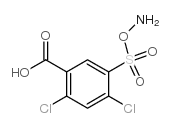Protein Disulfide Isomerase, from bovine liver

Protein Disulfide Isomerase, from bovine liver structure
|
Common Name | Protein Disulfide Isomerase, from bovine liver | ||
|---|---|---|---|---|
| CAS Number | 37318-49-3 | Molecular Weight | 286.08900 | |
| Density | 1.775g/cm3 | Boiling Point | 496.2ºC at 760 mmHg | |
| Molecular Formula | C7H5Cl2NO5S | Melting Point | N/A | |
| MSDS | Chinese USA | Flash Point | 253.9ºC | |
|
Oxidation, inactivation and aggregation of protein disulfide isomerase promoted by the bicarbonate-dependent peroxidase activity of human superoxide dismutase.
Arch. Biochem. Biophys. 557 , 72-81, (2014) Protein disulfide isomerase (PDI) is a dithiol-disulfide oxidoreductase that has essential roles in redox protein folding. PDI has been associated with protective roles against protein aggregation, a hallmark of neurodegenerative diseases. Intriguingly, PDI h... |
|
|
Periplasmic disulfide isomerase DsbC is involved in the reduction of copper binding protein CueP from Salmonella enterica serovar Typhimurium.
Biochem. Biophys. Res. Commun. 446(4) , 971-6, (2014) Salmonella enterica serovar Typhimurium (S. Typhimurium) is a facultative intracellular pathogen with the ability to survive and replicate in macrophages. Periplasmic copper binding protein CueP is known to confer copper resistance to S. Typhimurium, and has ... |
|
|
Therapeutic implications of protein disulfide isomerase inhibition in thrombotic disease.
Arterioscler. Thromb. Vasc. Biol. 35(1) , 16-23, (2015) The study of thrombus formation has increasingly applied in vivo tools such as genetically modified mice and intravital microscopy to the evaluation of molecular and cellular mechanisms of thrombosis. Among several unexpected findings of this approach was the... |
|
|
Membrane actions of 1α,25(OH)2D3 are mediated by Ca(2+)/calmodulin-dependent protein kinase II in bone and cartilage cells.
J. Steroid Biochem. Mol. Biol. 145 , 65-74, (2015) 1α,25(OH)2D3 regulates osteoblasts and chondrocytes via its membrane-associated receptor, protein disulfide isomerase A3 (Pdia3) in caveolae. 1α,25(OH)2D3 binding to Pdia3 leads to phospholipase-A2 (PLA2)-activating protein (PLAA) activation, stimulating cyto... |
|
|
Cell-type specific requirements for thiol/disulfide exchange during HIV-1 entry and infection.
Retrovirology 9 , 97, (2012) The role of disulfide bond remodeling in HIV-1 infection is well described, but the process still remains incompletely characterized. At present, the data have been predominantly obtained using established cell lines and/or CXCR4-tropic laboratory-adapted vir... |
|
|
The multidrug resistance IncA/C transferable plasmid encodes a novel domain-swapped dimeric protein-disulfide isomerase.
J. Biol. Chem. 289(5) , 2563-76, (2014) The multidrug resistance-encoding IncA/C conjugative plasmids disseminate antibiotic resistance genes among clinically relevant enteric bacteria. A plasmid-encoded disulfide isomerase is associated with conjugation. Sequence analysis of several IncA/C plasmid... |
|
|
Green tea catechins can bind and modify ERp57/PDIA3 activity.
Biochim. Biophys. Acta 1830(3) , 2671-82, (2013) Green tea is a rich source of polyphenols, mainly catechins (flavanols), which significantly contribute to the beneficial health effects of green tea in the prevention and treatment of various diseases. In this study the effects of four green tea catechins on... |
|
|
S-Nitrosylating protein disulphide isomerase mediates α-synuclein aggregation caused by methamphetamine exposure in PC12 cells.
Toxicol. Lett. 230(1) , 19-27, (2014) Methamphetamine (METH) belongs to Amphetamine-type stimulants, METH abusers are at high risk of neurodegenerative disorders, including Parkinson's disease (PD). However, there are still no effective treatments to METH-induced neurodegeneration because its mec... |
|
|
FrnE, a cadmium-inducible protein in Deinococcus radiodurans, is characterized as a disulfide isomerase chaperone in vitro and for its role in oxidative stress tolerance in vivo.
J. Bacteriol. 195(12) , 2880-6, (2013) Deinococcus radiodurans R1 exposed to a lethal dose of cadmium shows differential expression of a large number of genes, including frnE (drfrnE) and some of those involved in DNA repair and oxidative stress tolerance. The drfrnE::nptII mutant of D. radioduran... |
|
|
Endoplasmic reticulum stress-activated transcription factor ATF6α requires the disulfide isomerase PDIA5 to modulate chemoresistance.
Mol. Cell. Biol. 34(10) , 1839-49, (2014) ATF6α, a membrane-anchored transcription factor from the endoplasmic reticulum (ER) that modulates the cellular response to stress as an effector of the unfolded-protein response (UPR), is a key player in the development of tumors of different origin. ATF6α a... |